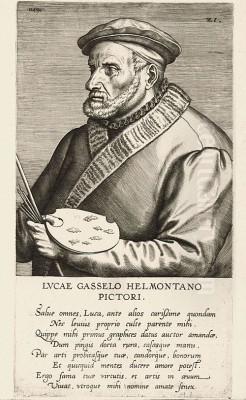
Lucas Gassel stands as a significant, albeit sometimes overlooked, figure in the rich tapestry of 16th-century Netherlandish art. Active during a period of profound artistic and intellectual transformation, Gassel specialized in landscape painting, contributing significantly to its emergence as an independent genre in Northern Europe. Born around 1500 and passing away circa 1569, his life spanned a crucial era that witnessed the flourishing of the Northern Renaissance, the rise of humanism, and the increasing demand for new types of imagery beyond purely religious commissions. Gassel's work is particularly associated with the development of the "world landscape" or Weltlandschaft, a style characterized by panoramic vistas, high viewpoints, and the integration of narrative elements within expansive natural settings.
Origins and Early Career
Historical records, though not exhaustive, place Lucas Gassel's birth in Helmond, a village located in the province of North Brabant in the present-day Netherlands, around the year 1500. This region was part of the vibrant cultural sphere of the Low Countries, which included major artistic centers like Antwerp and Brussels. While details of his specific training remain obscure, it is known that Gassel spent some time in the bustling port city of Antwerp, a major hub for artists and international trade during the early 16th century. This environment would undoubtedly have exposed him to a wide range of artistic currents, including the burgeoning interest in landscape painting.
Later, Gassel established himself in Brussels, another prominent center for the arts, particularly known for its tapestry production and courtly patronage. Brussels provided a different but equally stimulating environment. It was here that he likely spent the majority of his productive career, developing his distinctive style and contributing to the city's artistic life. His presence in these key cities places him firmly within the mainstream of Netherlandish art production of his time.
The Influence of Patenier and the World Landscape
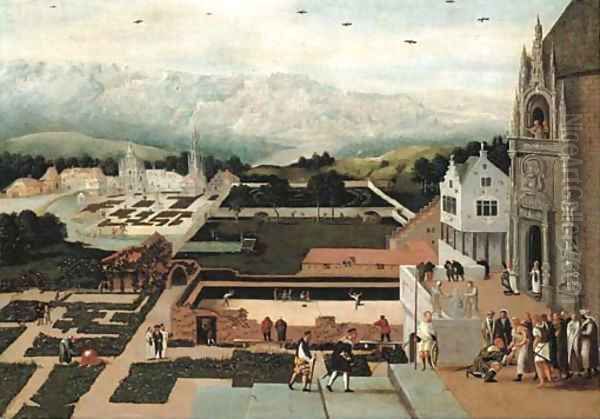
The most defining influence on Lucas Gassel's art was undoubtedly Joachim Patenier (c. 1480–1524). Patenier, often credited as the first true specialist landscape painter in the Low Countries, pioneered the Weltlandschaft. This innovative approach involved depicting vast, imaginary landscapes seen from an elevated viewpoint, encompassing mountains, rivers, seas, forests, and towns within a single composition. These landscapes often served as settings for small biblical or mythological scenes, but the landscape itself became the dominant subject.
Gassel embraced Patenier's formula wholeheartedly. His works consistently feature the characteristic high horizon line, the division of the pictorial space into distinct foreground, middle ground, and background zones (often marked by color shifts from warm browns and greens to cool blues), and the use of fantastic, craggy rock formations. Gassel, however, was not merely an imitator. He adapted and expanded upon Patenier's model, often incorporating more detailed architectural elements and sometimes lending his scenes a slightly more courtly or idyllic atmosphere compared to the often wilder vistas of his predecessor.
Gassel's Artistic Style and Techniques
Lucas Gassel's landscapes are typically panoramic and meticulously detailed. He skillfully employed atmospheric perspective, using color and clarity to suggest depth: warmer tones and sharper details in the foreground gradually give way to cooler, bluer, and hazier forms in the distance, effectively conveying a sense of vast space. His compositions often lead the viewer's eye through winding paths or rivers, inviting exploration of the depicted world.
A notable feature in Gassel's work is his integration of architecture. While Patenier included buildings, Gassel often gave them greater prominence and detail. These structures range from humble village dwellings and watermills to elaborate, sometimes fantastical, Renaissance-style palaces and gardens, as seen in works like Landscape with a Renaissance Palace in a Garden. This interest in architecture reflects broader Renaissance concerns with perspective, order, and the dialogue between the man-made and the natural world. It suggests an awareness of contemporary architectural trends, possibly influenced by prints or theoretical treatises circulating at the time.
Narrative remained important in Gassel's paintings, though often subordinated to the landscape. Biblical stories like the Flight into Egypt, the Sacrifice of Abraham, or David and Bathsheba unfold within his expansive settings. The figures enacting these dramas are typically small, emphasizing the grandeur and overwhelming scale of the natural or divinely created world. This approach aligns with a Northern European sensibility that often contemplated humanity's place within a larger cosmic order. His work Lot and His Daughters, for instance, uses the dramatic landscape to heighten the tension and moral weight of the biblical narrative.
Humanism and Intellectual Connections
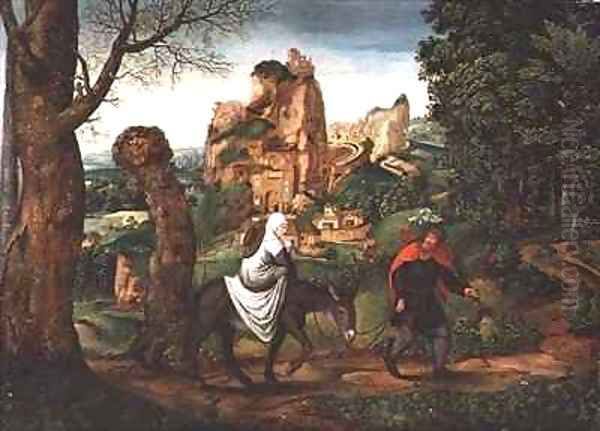
The available information suggests Lucas Gassel was associated with humanist circles, particularly mentioning a connection with Dominicus Lampsonius (1532–1599). Lampsonius was a notable figure – a humanist scholar, poet, and artist himself, perhaps best known for his Portraits of Some Celebrated Artists of the Low Countries (1572), an important early work of art history. Such connections indicate that Gassel was not an isolated craftsman but likely engaged with the intellectual currents of his time.
Humanism in the 16th century emphasized classical learning, rational inquiry, and a renewed interest in the natural world. This could be reflected in Gassel's detailed observation of nature (even when constructing imaginary scenes), his interest in perspective and architectural order, and potentially in his choice of subject matter, which sometimes included mythological or allegorical themes alongside biblical ones. The suggestion that Gassel might have traveled to Italy, particularly Venice, though unconfirmed, would fit this humanist profile, as Italy was the heartland of the Renaissance and a source of inspiration for many Northern artists seeking classical knowledge and new artistic techniques, especially regarding light and color, for which Venice was famed. Artists like Titian were already incorporating evocative landscapes into their works.
Representative Works
Several works exemplify Lucas Gassel's style and thematic concerns. The Landscape with a Renaissance Palace in a Garden (often simply referred to as Garden with Renaissance Palace) showcases his skill in combining detailed architectural rendering with a panoramic landscape background. The elegant palace and formal gardens in the foreground contrast with the wilder, mountainous terrain beyond, creating a dialogue between civilization and nature.
David and Bathsheba places the well-known biblical story within a complex urban and natural setting. The figures are relatively small, drawing the viewer's attention to the intricate cityscape, the palace architecture, and the surrounding landscape, demonstrating Gassel's primary focus on the environment. Similarly, The Sacrifice of Abraham uses the dramatic, rocky landscape typical of the Weltlandschaft style to frame the intense biblical moment, emphasizing divine power and the vastness of the world in which human dramas unfold.
The painting identified as Copper Mine, mentioned in relation to Gassel and his contemporary Pieter Bruegel the Elder, points towards an interest in depicting human activity and industry within the landscape, a theme Bruegel would explore extensively. While Bruegel is more famous for such scenes, its association with Gassel suggests a shared interest among artists of the period in representing the changing relationship between humanity and the environment, including resource extraction.
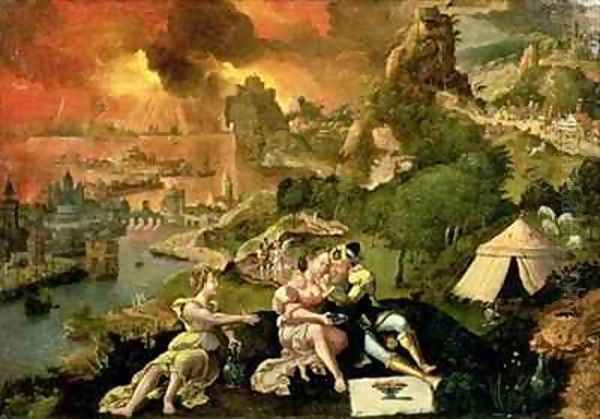
Another work, Flight into Egypt, a common theme in Netherlandish landscape painting allowing artists to showcase exotic scenery, was reportedly used as inspiration for a modern art installation. This highlights the enduring visual appeal and adaptability of Gassel's compositions, even centuries later. Lot and His Daughters is another example where the dramatic landscape setting amplifies the biblical narrative.
Contemporaries and Artistic Milieu
Lucas Gassel worked within a vibrant artistic community. His primary artistic debt, as noted, was to Joachim Patenier. Another close contemporary working in a very similar vein was Herri met de Bles (c. 1510 – c. 1555-1560). Bles also specialized in panoramic landscapes with fantastic rock formations, often including biblical scenes. The stylistic similarities between Gassel and Bles are significant, and their works have sometimes been confused. The exact nature of their relationship – whether one influenced the other, or if they were simply parallel developments from Patenier's legacy – remains debated by art historians. Some sources suggest Bles may have been a student of Gassel, but this is not definitively proven.
The towering figure of the era was Pieter Bruegel the Elder (c. 1525–1569). While Bruegel also employed high viewpoints and panoramic scopes in works like his Months series, his focus shifted more towards peasant life, social commentary, and a more naturalistic (though still composed) representation of landscape. Bruegel likely knew the work of Gassel and Bles, absorbing the Weltlandschaft tradition before transforming it with his unique genius. Gassel and Bruegel were contemporaries in Brussels during the later part of Gassel's life.
Other important artists active in the Low Countries during Gassel's time, whose work formed the broader context for his own, include:
Quentin Matsys (1466–1530): An earlier Antwerp master who began incorporating more prominent landscape backgrounds in his religious paintings.
Jan Gossaert (c. 1478–1532): One of the first "Romanists" who traveled to Italy and introduced Renaissance motifs and a focus on the human form, though he also painted works with landscape elements.
Bernard van Orley (c. 1487–1541): A leading Brussels artist, court painter, and designer of tapestries, whose workshop was highly influential. Gassel would certainly have been aware of his work.
Pieter Coecke van Aelst (1502–1550): An influential Antwerp artist, architect, and publisher who traveled widely (including to Constantinople) and helped disseminate Renaissance ideas.
Jan van Scorel (1495–1562) and Maerten van Heemskerck (1498–1574): Prominent Dutch painters who spent significant time in Italy and brought back a strongly classicizing style, impacting art across the Low Countries.
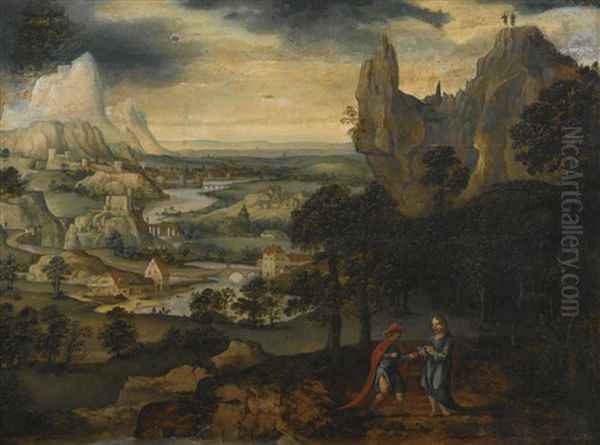
Gassel's connection with the humanist Dominicus Lampsonius also places him within an intellectual network interested in documenting and promoting Netherlandish art.
Later Life and Legacy
Lucas Gassel continued to paint into his later years, remaining active in Brussels. The exact date of his death is subject to minor discrepancy in historical sources, with some citing 1569 and others suggesting the period 1568/69. Regardless, he passed away around the same time as his famous contemporary, Pieter Bruegel the Elder.
Gassel's primary legacy lies in his role as a key practitioner and propagator of the Weltlandschaft style. He, along with Herri met de Bles, formed a crucial link between the pioneering work of Joachim Patenier and the subsequent evolution of landscape painting. While perhaps overshadowed in fame by Patenier before him and Bruegel beside him, Gassel produced a substantial body of work that catered to the growing market for landscape imagery. His paintings, with their blend of detailed observation, imaginative construction, narrative interest, and decorative appeal, were popular among patrons.
His work helped solidify landscape as a respectable and desirable genre in its own right, paving the way for later generations of Netherlandish artists who would specialize further. Artists of the later 16th and early 17th centuries, such as Gillis van Coninxloo (1544–1607), Paul Bril (1554–1626), and Jan Brueghel the Elder (1568–1625), would build upon the foundations laid by Gassel and his contemporaries, developing forest landscapes, marine views, and more naturalistic approaches, eventually leading to the golden age of Dutch landscape painting in the 17th century.
In conclusion, Lucas Gassel was a skilled and productive painter who played an important role in the history of European landscape art. As a follower and adapter of Joachim Patenier's world landscape formula, he created expansive, detailed, and often enchanting vistas that captured the 16th-century fascination with the natural world and humanity's place within it. His integration of architecture, his narrative compositions, and his position within the artistic networks of Antwerp and Brussels mark him as a significant contributor to the Northern Renaissance. His paintings remain valuable testaments to the artistic ambitions and visual imagination of his era.